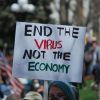With the state of Colorado delegating most COVID-related decisions to each county, it is time to address the unreasonable restrictions imposed on gyms, fitness facilities, health clubs, exercise studios, and recreation centers.
The vast majority of these establishments have been disproportionately unable to secure government-funded pandemic support due to their operational configurations (i.e., their facility costs are much higher than their labor costs). Sadly, due to ill-considered public policies, many of these enterprises have ceased business.
Public health officials — often accused of being overly controlling — consistently have ignored the science as well as the mental and other physical health needs of our citizenry. Giving people the opportunity to be active again — after over a year of isolation — is an immediate need due to the severe physical and psychological damage so many have suffered.
The most recent infection and transmission rate studies show fully vaccinated people (i.e., those who are two weeks past completing their vaccination protocols) are extremely unlikely to get COVID.
And the possibility of actual transmission by fully vaccinated people to others who also are fully vaccinated asymptotically approaches zero. Therefore, fully vaccinated people present no significant threat to others.
Hence, the science says anyone who is fully vaccinated no longer needs to wear a mask or socially distance.
Despite these facts, some public officials understandably are likely to continue to impose mask restrictions due to their concern that having some people needing to be masked while others are unmasked would cause confusion.
For instance, is an unmasked person fully vaccinated or are they just refusing to wear a mask?
In uncontrolled public settings, this is challenging and, therefore, masking requirements may be seen as necessary for the public as a whole.
However, in controlled settings, this problem is easily resolved. That is, the need for “unnecessary” masking and physical distancing can be eliminated entirely.
For example, at a gym, fitness center, health club, studio, recreation center, or similar facility, the operators control who enters their premises.
They easily can give fully-vaccinated patrons a wristband, stamp, badge, sticker, or something else which prominently shows who has permission to not wear a mask.
This is an approach that also could be deployed for large-scale indoor and outdoor events.
This solution also could be extended to anyone who recently (e.g., within 72 hours) tested negative for COVID, including those entering a facility by utilizing an onsite rapid test.
However, due to potential error rates (i.e., false negatives), this would require a well-delineated policy before being put into use. Nevertheless, it should be an aspirational goal for state public health officials.
For controlled environments, allowing facilities to free fully vaccinated patrons from masking, physical distancing, equipment limitations, and capacity requirements would be extraordinarily helpful to millions of citizens and to the thousands of facilities that have suffered severely from the pandemic. This especially applies to the small businesses without significant financial resources to tide them over.
Most importantly, the available data specific to these facilities have proven they have not been a source of COVID spread.
A University of Oregon study, which examined 8.5 million Colorado facility check-ins, found that none of them were related to the 59 outbreaks which occurred in the relevant study period.
“Based on Colorado data as a proxy, there is no correlation between health club visits and COVID-19 cases,” the study concluded. “Relative to other public spaces like restaurants and bars, health and fitness facilities are lower risk environments.”
This followed a separate national study which found “1,155 cases of COVID-19 resulted from more than 49 million gym check-ins — 0.0023%.” This is an infinitesimal occurrence rate.
This hard data informs us that health, fitness, and recreation facilities cannot be classified as “super-spreaders” or even be described as “spreaders” of any kind. They always have been safe environments.
Additionally, the people who use these kinds of facilities probably are more health and safety-conscious than the average person so they’re typically being very careful as well.
They do not need to have physical distancing or masking requirements imposed on them. They do not need to have equipment labeled “Off Limits” or temporarily removed from a facility.
These people can be depended on to make rational decisions. And, if they are fully vaccinated, the need for restrictive measures immediately becomes moot.
Hopefully, Colorado’s public health officials at every level will “follow the science” and adapt their policies accordingly. It’s time to free our gyms!




